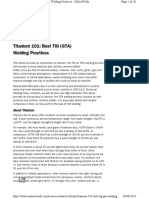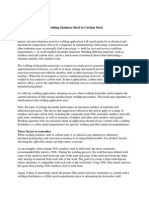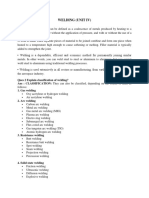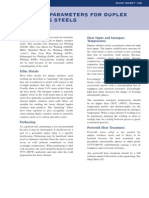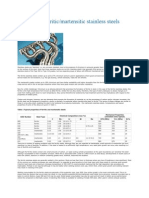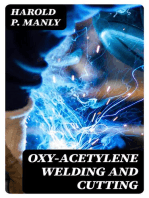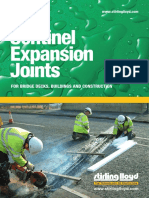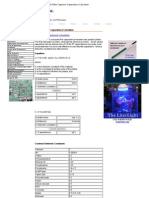300 SS Tig
300 SS Tig
Uploaded by
Sameer KhanCopyright:
Available Formats
300 SS Tig
300 SS Tig
Uploaded by
Sameer KhanOriginal Description:
Copyright
Available Formats
Share this document
Did you find this document useful?
Is this content inappropriate?
Copyright:
Available Formats
300 SS Tig
300 SS Tig
Uploaded by
Sameer KhanCopyright:
Available Formats
300 Series Stainless Tig Welding
Due to its long-term cost effectiveness and inherent corrosion resistance, austenitic stainless steel has become a staple material across many industries. Also known as 300 series, austenitic stainless steel poses distinct challenges when TIG welded, the greatest of which are carbide precipitation and distortion. The key to preventing these pitfalls is good heat control, correct travel speeds and adequate gas coverage. Austenitic Stainless Steel Basics: By its very nature, austenitic stainless steel is a poor conductor of heat. The presence of nickel (6-22%), along with chromium (16-26%), enhances its corrosion and/or stain resistance, but these and other elementsoften titanium or molybdenumalso cause it to react to heat differently than other materials. Effectively, austenitic stainless steel conducts heat at around half the rate of mild steel, but has a much higher rate of thermal expansion when welded.
Good heat control, gas coverage and travel speeds can help ensure TIG welding success on stainless steel. Typically, austenitic stainless steel requires a DC power source and pointed tungsten (any type except pure) to TIG weld it. Like aluminum, it should be free of oil, paint and/or dirt prior to welding to achieve optimal results. Unlike aluminum, however, austenitic stainless steel does not require wire brushing prior to welding. Instead, the material should be wire brushed between welding passes with a stainless steel wire brush that has not had contact with steel to help remove potential interpass oxides. Filler rod is recommended on applications with a base material thicker than gauge 18 and will be contingent upon joint design. For example, outside corners may not require filler rod, but an inside joint will. Most TIG applications require overmatching of the filler rod. That is, a filler rod with higher strength properties should be used. For example, on 304 series austenitic stainless steel, an ER308 rod should be used. Typically, austenitic stainless steel filler rods are available in diameters ranging from .035 to 5/32 (.9-to 4.0-mm) and chosen according to the joint design, welding parameters and applications.
Filler Rod Selection. Stainless Steel 301 302 302S 304 304L 305 308 309 309S 310 Filler Rod Used 308 308 308 308 308 308, 310 308 309 309 310 Stainless Steel 310S 314 316 316L 317 321 330 347 348 Filler Rod Used 310 310, 312 316 316 347 347 347 347 347, 348
What is Carbide Precipitation? Carbide precipitation occurs when the chrome and carbon in the austenitic stainless steel is drawn out of the material and reacts to the atmosphere. It occurs between 800 to 1400 degrees Fahrenheit (426 to 760 degrees Celsius), so care should be taken to keep the weld zone below that range or in an inert atmosphere (via argon shielding gas). Because austenitic stainless steel is easily readable when weldeda good weld is straw colored. It is equally easy to detect when carbide precipitation has occurred: the austenitic stainless steel will turn black. When carbide precipitation is present: the material will turn blue or purple after being TIG welded. There are three causes of carbide precipitation: heat, travel speed and gas. Specifically, too hot of a TIG weld, too slow of travel speed and/or inadequate shielding gas coverage can individually, or in combination, cause the problem. Heat and Travel Speed. The best defense against carbide precipitation is practice and a few key guidelines. 1) The rule of amperages: unlike the rule for steel, stainless steel requires 1/3rd less amps for every thousandths of an inch of material thickness.
2) Maintaining an appropriate travel speed helps prevent an excess amount of heat from entering the TIG weld. 3) Choosing the correct tungsten diameter and grind on the tip. See page 7. Aside from practice, one way to monitor travel speed is to look for what is dubbed the devils eye. The devils eye is a fluid dot in the center of the weld puddle that is formed by foreign elements that continuously dance around in the center of the weld puddle. The presence of the devils eye is insurance that not only is travel speed appropriate, but also that other factors like torch angle, filler rod position, penetration and root opening are all optimal. As you are welding try to keep the HAZ as narrow as possible while still maintaining good penetration. Many people hold their breath in an effort to become steadier or they hold too tightly on to the torch. Relax and breathe normally while maintain a gently grip on the torch. This will avoid hand fatigue and shaking while welding. Gas Coverage. Using the appropriate type and amount of shielding gas is another important way to prevent carbide precipitation. Typically, pure argon provides the best results when welding thinner austenitic stainless steel, but the addition of small percentages of hydrogen is not uncommon when faster travel speeds are desired, especially on thicker pieces or in automated application. The average flow required is between 15 to 20 psi, anything greater will cause turbulence in the gas flow and weld puddle and result in a poor weld. The use of a gas lens is highly recommended when TIG welding austenitic stainless steel. A gas lens is a copper and brass component with layered stainless steel mesh screens that replaces the collet body in a standard GTAW torch. The gas lens helps distribute gas more evenly around the tungsten, arc and weld puddle and provides good cooling action. Full penetration welds require back purging. Covering the back of the weld with shielding gas ensures that the underside of the weld is protected from atmospheric elements and can be done with commercial apparatuses or individually manufactured methods. Finally, remember to maintain adequate post-flow. The best practice is to maintain one second of post-flow for every 10 amps of welding current used during welding. Avoiding Distortion and Cracking. Because stainless steel is prone to greater thermal expansion than other materials it tends to distort easily. Too high of a current setting and/or too slow of travel speeds contribute to this problem. Thermal expansion occurs because the HAZ (heat affected zone) on austenitic stainless steel is more localized than with other materials. When the weld cools, there is slow thermal transfer to the surrounding material that can lead to buckling. By clamping or using a fixture, especially on thin gauge material, you can reduce the chances of buckling Along with distortion comes the potential for cracking, By using a joint design consisting of a V-grove, modified V-grove, U-grove of a J-grove that limits the number of weld passes and the amount of heat applied the chance of cracking will be reduced. Cracking will also occur in the
weld initiation and crater area. One way to prevent cracking in this area is to use run-on/run-off tabs. These tabs need to match the base material for the best results. The tabs provide an area to run-on or run-off the weld thus eliminating arc starting and craters on the actual weld joint
Notice the narrow heat affected zone (HAZ) created by high speed pulsed TIG, which helps preserve the metals original properties. and can be easily ground or cut off-after the weld cools Remember: even with the right type and amount of gas, good heat input and proper travel speeds, training and practice is still the best defense against the pitfalls of TIG welding austenitic stainless steels.
The Art of TIG Welding When TIG welding stainless there are a few points to keep in mind to achieve a cosmetically appealing and sound weld. Because stainless steel does not adequately dissipate heat, maintaining proper heat input when welding is critical. Too much heat can lead to warping, embrittlement or rust. As little as five amps too much can damage stainless steels properties. There are, however, several ways to control heat input:
Good fit-up: Adding filler metal to fill gaps puts more heat into the part, so good fit-up is important. Its impossible to add a lot of filler metal and keep energy out of the part. The correct filler metal: The filler metal diameter should be thinner than the base metal. If its thicker than the base metal, too much heat is needed to melt the filler metal. The filler metal should also match the base metal alloys in order to maintain consistent mechanical and corrosion properties. Stainless Filler Rod Stainless Filler Rod
Steel 301 302 302S 304 304L 305 308 309 309S 310
Used 308 308 308 308 308 308, 310 308 309 309 310
Steel 310S 314 316 316L 317 321 330 347 348
Used 310 310, 312 316 316 347 347 347 347 347, 348
Choose the right tungsten size: You cant weld precisely on 1/16-in. material with a 1/8-in. tungsten. Use the right tungsten diameter based on your amperage. See page 7 for the proper size. Use the correct tungsten geometry: The tungstens shape plays a role in the welds width and penetration. In welding stainless steel, the sharper the tungsten, the wider and less penetrating the bead will be. On a sharper point, (ground to a taper length that is more than 2 times the electrode diameter), the arc tends to fan out, creating a wider heat affected zone. With a blunter point (less than 2.5 times the electrode diameter), the arc comes straight down with less flaring for a deeper, thinner bead and thinner heat affected zone. Use a fingertip or foot control: You need to be able to start the arc and adjust the amperage from the beginning to the end of the weld. Set the welder to the desired amperage, which should be just a bit more power than youll need. If your welder is fairly accurate, youll only need to adjust the fingertip or foot control a little bit to adjust welding output. Start with low amperage and allow the puddle to form: Then back off two or three amps and add filler. Maintain the correct puddle size: The weld puddle should be the thickness of the base metal. If the puddle grows too large, turn down the heat. Eliminate craters by easing down the current at the end of the weld and adding filler metal until the puddle solidifies. Use your torchs fingertip or foot pedal control or your welders sequencer.
Keep the gas flowing and directed at the puddle until the orange color fades. The post flow also cools the puddle and the tungsten. Moving the torch too fast can blow gas away from the tungsten, turn it black and make it more difficult to start next time. Use pulsing. To control heat input, use a welder with DC pulsing capabilities. In pulsing, the current transitions between a high peak amperage and a low background amperage that maintains the arc but allows the puddle to cool. The peak current provides good penetration, but the background current allows the weld puddle to cool slightly, preventing warping, embrittlement and carbide precipitation. Pulses per Second (PPS): Is simply how many times the machine will complete one pulsing cycle in a time span of one second. Increasing the number of pulses per second produces a smoother ripple effect in the weld bead, narrows the weld bead. Reducing the number of pulses per second widens the weld bead. Pulsing also helps agitate the puddle and release any porosity or gas trapped in the weld. Some beginning TIG welders use a slow pulsing rate (perhaps .5 to 1 PPS) to help them develop a rhythm for adding filler metal. For welding carbon or stainless steel, use a rate of 100 to 500 PPS. Start at 100 and work upward. Higher pulsing (generally above 100 pulses per second) increase puddle agitation, which in turn produces a better grain molecular structure within the weld. High speed pulsing also constricts and focuses the arc. This increases arc stability, penetration and travel speeds, and it produces a smaller heat-affected zone.
Table 2: Austenitic, Super-Austenitic and Duplex Stainless Steel Alloys
Base Metal
Carbon and Low Alloy Steel Type 304 SS Type 304H SS Type 316L SS 304L 304H 316L 317L 904L 6% Mo SS ABC 7% Mo SS ABC Alloy 20CCb-3 ABC 2304 Duplex N 2205 Duplex N
ABC
ABC
ABC
ABC
ABC
DE E
DF EF FG
DG EG FG
DC * FC
C * FC
C * FC
DCH ECH FCH
NL * NL
NL * NL
Type 317L SS Type 904L SS Type 6% Mo SS Eg: 254 SMO, AL 6XN Type 7% Mo SS Eg: 654 SMO Type Alloy 20Cb3 Type 2304 Duplex SS Type 2205 Duplex SS
GC
GC C
GC C CJK
GC C CJK
GC C *
L L *
L L *
CJK
LM
LM
LM
Legend
A) AWS A 5.4 Classification E309L-XX B) AWS A 5.11 Classification ENiCrFe-2 or -3 (-2 is Alloy 718 and -3 is Inconel 182) C) AWS A 5.11 Classification ENiCrMo-3 (Inconel 625) D) AWS A 5.4 Classification E308L-XX E) AWS A 5.4 Classification E308H-XX F) AWS A 5.4 Classification E316L-XX G) AWS A 5.4 Classification E317L-XX H) AWS A 5.4 Classification E320LR-XX
Notes:
1. Table 2 refers to coated electrodes only. For bare wire welding (GMAW, GTAW), use equivalent electrode classification (AWS A 5.14) 2. There are many proprietary alloys available in the market and material combinations you might encounter. Consult the manufacturer or the DSF for proper filler metal selection
J) AWS A 5.11 Classification ENiCrMo-4(Hastelloy C-276)
K) AWS A 5.11 Classification ENiCrMo-11 (Hastelloy G-30) L) AWS A 5.4 Classification E2209-XX M) AWS A 5.4 Classification E2553-XX N) AWS A 5.4 Classification E309MoL-XX
Unlikely combination
TIG (GTAW) Calculator, Stainless Steel
Work Thickness In.
1/16
Weld Type
Butt Lap Corner Fillet Butt Lap Corner Fillet Butt Lap Corner Fillet Butt Lap Corner Fillet Butt Lap Corner Fillet Butt Lap Corner Fillet
No.
1 4, 5 6, 7, 9 10 1 4, 5 6, 7, 9 10 1 4, 5 6, 7, 9 10 1 4, 5 6, 7, 9 10 1, 2 5 6, 7, 8 10 2, 3 5 8 10
Tungsten Electrode Dia.
1/16 1/16 1/16 1/16 1/16 1/16 1/16 1/16 1/16 1/16 1/16 1/16 3/32 3/32 3/32 3/32 1/8 1/8 1/8 1/8 1/8 or 3/16 1/8 or 3/16 1/8 or 3/16 1/8 or 3/16
Cup Orifice Dia.
1/4-3/8 1/4-3/8 1/4-3/8 1/4-3/8 1/4-3/8 1/4-3/8 1/4-3/8 1/4-3/8 1/4-3/8 1/4-3/8 1/4-3/8 1/4-3/8 1/4-3/8 1/4-3/8 1/4-3/8 1/4-3/8 1/2 1/2 1/2 1/2 1/2 1/2 1/2 1/2
Filler Rod Dia.
1/16 1/16 1/16 1/16 1/16 or 3/32 1/16 or 3/32 1/16 or 3/32 1/16 or 3/32 3/32 3/32 3/32 3/32 1/8 1/8 1/8 1/8 3/16 3/16 3/16 3/16 1/4 1/4 1/4 1/4
Current
Flat Welding
Gas Type
Ar Ar Ar Ar Ar Ar Ar Ar Ar Ar Ar Ar Ar Ar Ar Ar Ar Ar Ar Ar Ar Ar Ar Ar
Type
DC DC DC DC DC DC DC DC DC DC DC DC DC DC DC DC DC DC DC DC DC DC DC DC
Amps
50-80 60-90 50-80 60-90 80-100 90-120 80-100 90-120 85-120 100-140 85-120 100-140 125-200 150-200 150-200 175-225 225-300 250-325 250-300 250-320 300-400 325-425 325-425 325-425
Flow
11 11 11 11 11 11 11 11 11 11 11 11 13 13 13 13 13 13 13 13 15 15 15 15
PSI
20 20 20 20 20 20 20 20 20 20 20 20 20 20 20 20 20 20 20 20 20 20 20 20
Speed in/mi n
12 10 12 10 12 10 12 10 12 10 12 10 10 8 10 8 5 5 5 5
Remarks
Stainless Steel Manual Welding Straight Polarity D.C. For Mild Steel, Use 10% Higher Amperage Values
3/32
1/8
3/16
1/4
1 or 2 passes 1 or 2 passes 1 pass 2 or 3 passes 3 passes 3 passes 3 passes
1/2
NOTES: Reduce currents 10% to 20% for vertical and overhead. Ceramic or glass cup should be used for currents to 250 amps. Water-cooled cup should be used for currents above 250 amps. Types of Tungsten Electrodes Pure, (Green). Good arc stability on AC current, with either balanced wave or continuous high frequency stabilization. Preferred for AC welding of aluminum and magnesium. When heated, the pure tungsten electrode forms a balled end. 2% Ceriated, (Orange). The most abundant of the rare earth elements. These are all-purpose electrodes that will operate with AC or DC of either polarity. Provide long life and high current-carrying capacity. Unlike Thoriated, Ceriated is not a radioactive material. 1% Lanthanum, (Black), Often refereed to as Lanthana, another of the rare earth elements. The operating characteristics are very similar to the Ceriated electrode. 2% Thoriated, (Red), 1% Thoriated, (Yellow), Designed for DC applications. Thoria content is dispersed evenly throughout their entire length. Maintains a sharpened point well, which is desirable for welding steels. Good are starting and high current carrying capacity. Thoria content is responsible for increasing the life of the electrode. Zirconium, (Brown), Designed for AC welding when the highest quality work is necessary. Contains less than 1% zirconium oxide, which produces a very stable arc. Current carrying capacity equal to or greater than equal-sized thorium electrode. Not recommended for DC welding.
Gauge to Decimal to Millimeter Conversion Chart
Gauge ( ga. ) 3 4 5 6 7 8 9 10 11 12 13 14 15 16 17 18 19 20 21 22 23 24 25 26 27 28 29 30 31 32 33 Standard Steel Thickness inch 0.2391 0.2242 0.2092 0.1943 0.1793 0.1644 0.1495 0.1345 0.1196 0.1046 0.0897 0.0747 0.0673 0.0598 0.0538 0.0478 0.0418 0.0359 0.0329 0.0299 0.0269 0.0239 0.0209 0.0179 0.0164 0.0149 0.0135 0.0120 0.0105 0.0097 0.0090 mm 6.08 5.71 5.32 4.91 4.55 4.18 3.78 3.42 3.01 2.65 2.27 1.89 1.71 1.50 1.35 1.21 1.05 0.90 0.82 0.75 0.68 0.59 0.52 0.46 0.42 0.37 0.35 0.31 0.27 0.25 0.23 0.1532 0.1382 0.1233 0.1084 0.0934 0.0785 0.0710 0.0635 0.0575 0.0516 0.0456 0.0396 0.0366 0.0336 0.0306 0.0276 0.0247 0.0217 0.0202 0.0187 0.0172 0.0157 0.0142 0.0134 3.89 3.52 3.13 2.74 2.36 2.00 1.81 1.62 1.45 1.31 1.16 1.00 0.93 0.86 0.76 0.70 0.63 0.55 0.52 0.47 0.44 0.39 0.36 0.34 Galvanized Steel Thickness inch mm Aluminum Thickness inch 0.2294 0.2043 0.1819 0.1620 0.1443 0.1285 0.1144 0.1019 0.0907 0.0808 0.0720 0.0641 0.0571 0.0508 0.0453 0.0403 0.0359 0.0320 0.0285 0.0253 0.0226 0.0201 0.0179 0.0159 0.0142 0.0126 0.0113 0.0100 0.0089 0.0080 0.0071 mm 5.83 5.20 4.61 4.13 3.67 3.25 2.90 2.57 2.29 2.05 1.85 1.63 1.45 1.27 1.16 1.02 0.90 0.81 0.73 0.65 0.57 0.51 0.46 0.39 0.37 0.32 0.30 0.26 0.22 0.20 0.18
34 35 36
0.0082 0.0075 0.0067
0.20 0.19 0.17
0.0063 0.0056
0.16 0.14
You might also like
- Spreader Beam BLOCK EDocument23 pagesSpreader Beam BLOCK Evaminos86% (14)
- 12 Tig WeldingDocument8 pages12 Tig WeldingSampath KumarNo ratings yet
- BS EN 1011-3-2000 - Recommendations For Arc Welding of Stainless Steels PDFDocument25 pagesBS EN 1011-3-2000 - Recommendations For Arc Welding of Stainless Steels PDF0502ravi100% (1)
- Weld Like a Pro: Beginning to Advanced TechniquesFrom EverandWeld Like a Pro: Beginning to Advanced TechniquesRating: 4.5 out of 5 stars4.5/5 (6)
- Coefficient of Friction of PipesDocument1 pageCoefficient of Friction of PipesAlden CayagaNo ratings yet
- Research Project Final Part 1Document28 pagesResearch Project Final Part 1EmersonG.Alverde0% (1)
- Best Practices For TIG Welding 1Document6 pagesBest Practices For TIG Welding 1Orlando1949No ratings yet
- Austenitic Stainless SteelsDocument4 pagesAustenitic Stainless Steelsandy1036100% (2)
- Titanium - Welding and Heat Treating: Topics CoveredDocument13 pagesTitanium - Welding and Heat Treating: Topics CoveredSisira Chandrasoma100% (1)
- TIG IT: How A TIG Welder Works and When To TIG WeldDocument6 pagesTIG IT: How A TIG Welder Works and When To TIG WeldHakim AzizanNo ratings yet
- Miller Welding TitaniumDocument20 pagesMiller Welding TitaniumrcpretoriusNo ratings yet
- Tig Welding Tips NewDocument5 pagesTig Welding Tips NewKentDemeterioNo ratings yet
- Titanium Welding ProcedureDocument5 pagesTitanium Welding ProcedureHarminder KumarNo ratings yet
- TIG Presentation.Document31 pagesTIG Presentation.Md Anamul HoqueNo ratings yet
- Sheet Metal Welding-Tips PDFDocument5 pagesSheet Metal Welding-Tips PDFMphilipTNo ratings yet
- About Titanium WeldingDocument6 pagesAbout Titanium Weldingckkashyap0007No ratings yet
- Tips For Successfully Welding Stainless Steel To Carbon SteelDocument5 pagesTips For Successfully Welding Stainless Steel To Carbon SteelAchu Balachandran100% (1)
- Seminar Report TIGDocument13 pagesSeminar Report TIGRahul ShawNo ratings yet
- Annealing Stainless Steel 304-316Document4 pagesAnnealing Stainless Steel 304-316nepcom9541No ratings yet
- Arc Welding Process PDFDocument12 pagesArc Welding Process PDFBiswanath RoulNo ratings yet
- Weldability and Joining of Materials: Titanium and Titanium AlloysDocument4 pagesWeldability and Joining of Materials: Titanium and Titanium AlloysMehmet SoysalNo ratings yet
- Basic Weld JointsDocument10 pagesBasic Weld JointsSham AmirNo ratings yet
- Welding: Group D: Tarang Valecha Dhananjay R. Apurva Mali Prateek SinghDocument16 pagesWelding: Group D: Tarang Valecha Dhananjay R. Apurva Mali Prateek SinghcfcshakerNo ratings yet
- Welding A Cast IronDocument9 pagesWelding A Cast Ironjatin jainNo ratings yet
- AGA Stainless Steel MIG MAG Welding Brochure 105x210 UsaDocument16 pagesAGA Stainless Steel MIG MAG Welding Brochure 105x210 UsaSriram IyerNo ratings yet
- Gas Tungsten-Arc Welding GTAW - Welding TechnologyDocument2 pagesGas Tungsten-Arc Welding GTAW - Welding TechnologyMuhammadNo ratings yet
- Titanium WeldingDocument6 pagesTitanium WeldingMichael ClaphamNo ratings yet
- Titanium 101Document19 pagesTitanium 101MOHAN100% (2)
- Basic TIG WeldingDocument9 pagesBasic TIG WeldingMardeOpamenNo ratings yet
- Welding (Unit Iv)Document19 pagesWelding (Unit Iv)Susheel GuptaNo ratings yet
- Tips For Successfully Welding Stainless Steel To Carbon SteelDocument2 pagesTips For Successfully Welding Stainless Steel To Carbon SteeladityaNo ratings yet
- Tig RwtiDocument39 pagesTig RwtiSaptarshi PalNo ratings yet
- Stainless Steel Welding by Weld RealityDocument50 pagesStainless Steel Welding by Weld RealitylightwinterdayNo ratings yet
- Gas WeldingDocument22 pagesGas WeldingShalin Sharma50% (2)
- Asi304& Mild SteelDocument28 pagesAsi304& Mild SteelArnab BhattacharyaNo ratings yet
- Welding of Nickel AlloysDocument4 pagesWelding of Nickel AlloysMuhammed SulfeekNo ratings yet
- A Beginner's Guide To TIG WeldingDocument5 pagesA Beginner's Guide To TIG WeldingKalaimugilan ArunNo ratings yet
- Welding Consumables-Stainless SteelDocument32 pagesWelding Consumables-Stainless SteelImran Khan100% (1)
- Analysis of Tig Welding Weldment and Defect Identification Using Non Destructive Testing NDTDocument48 pagesAnalysis of Tig Welding Weldment and Defect Identification Using Non Destructive Testing NDTRebecca KelleyNo ratings yet
- Braze WeldingDocument2 pagesBraze Weldingkevin herryNo ratings yet
- How To Weld 254 SMO PDFDocument12 pagesHow To Weld 254 SMO PDFPrabhakar KattulaNo ratings yet
- Mig WireDocument10 pagesMig WireSathishkumar SrinivasanNo ratings yet
- 304 SsDocument54 pages304 Ssshakir ramzanNo ratings yet
- Section 12 - Welding Consumables - Stainless Steel266 - 27357Document106 pagesSection 12 - Welding Consumables - Stainless Steel266 - 27357getgateclose100% (1)
- IMOA Shop Sheet 105Document2 pagesIMOA Shop Sheet 105liamcsNo ratings yet
- Description of Tig Welding Final 1Document4 pagesDescription of Tig Welding Final 1api-355092514No ratings yet
- Welding Metallurgy of Titanium AlloysDocument46 pagesWelding Metallurgy of Titanium AlloysBaraneedharanNo ratings yet
- Welding NPTEL Lecturers - Part4Document30 pagesWelding NPTEL Lecturers - Part4Sai ChaithanyaNo ratings yet
- Welding of Ferritic/martensitic Stainless Steels: Job KnowledgeDocument2 pagesWelding of Ferritic/martensitic Stainless Steels: Job KnowledgeMuhammed SulfeekNo ratings yet
- Welding of Titanium and Its AlloysDocument3 pagesWelding of Titanium and Its AlloysMuhammed SulfeekNo ratings yet
- 1.07 TIG Welding Part-2Document79 pages1.07 TIG Welding Part-2rohit mathanker100% (1)
- TIG Welding: Job KnowledgeDocument3 pagesTIG Welding: Job KnowledgeRakesh Kumar Munda100% (1)
- SS - Filler Wire SelectionDocument26 pagesSS - Filler Wire SelectionBaraa AzebNo ratings yet
- Bohler - Manual de Reparatii Prin SuduraDocument53 pagesBohler - Manual de Reparatii Prin Suduracostelino72100% (1)
- Stick Welding - How To Create High Quality WeldsDocument5 pagesStick Welding - How To Create High Quality Weldssenthil4youNo ratings yet
- JJ205 Workshop Technology Tic&Mic WeldingDocument47 pagesJJ205 Workshop Technology Tic&Mic WeldingAh TiangNo ratings yet
- Tigweld DoneDocument16 pagesTigweld DoneSenthil KumarNo ratings yet
- Bolted Flanged Joint: Flanges, Studs & Gaskets. Recommended Practices for the Assembly of a Bolted Flange Joint.From EverandBolted Flanged Joint: Flanges, Studs & Gaskets. Recommended Practices for the Assembly of a Bolted Flange Joint.No ratings yet
- Oxy-Acetylene Welding and Cutting Electric, Forge and Thermit Welding together with related methods and materials used in metal working and the oxygen process for removal of carbonFrom EverandOxy-Acetylene Welding and Cutting Electric, Forge and Thermit Welding together with related methods and materials used in metal working and the oxygen process for removal of carbonNo ratings yet
- Oxy-Acetylene Welding and Cutting: Electric, Forge and Thermit Welding together with related methods and materials used in metal working and the oxygen process for removal of carbonFrom EverandOxy-Acetylene Welding and Cutting: Electric, Forge and Thermit Welding together with related methods and materials used in metal working and the oxygen process for removal of carbonNo ratings yet
- Soldering Electronic Components 2nd EditionFrom EverandSoldering Electronic Components 2nd EditionRating: 3 out of 5 stars3/5 (2)
- Correlation of Bendability of Materials With Their Tensile Properties Datsko Bab4480.0001.001Document21 pagesCorrelation of Bendability of Materials With Their Tensile Properties Datsko Bab4480.0001.001lram70No ratings yet
- Mechatronics and Automotive Systems DesignDocument6 pagesMechatronics and Automotive Systems DesignscientificstuffNo ratings yet
- Practical Training PresentationDocument29 pagesPractical Training PresentationpoojaNo ratings yet
- 2.1 Sentinel Expansion Joints BrochureDocument8 pages2.1 Sentinel Expansion Joints BrochuremahmoudbadwyNo ratings yet
- Data Driven Infra ScreenDocument62 pagesData Driven Infra ScreenLevious FajarNo ratings yet
- Cfm56-3 Engine Regulation by CFMDocument43 pagesCfm56-3 Engine Regulation by CFMnono92100% (5)
- Chapter 4-Building Structural SystemDocument56 pagesChapter 4-Building Structural SystemYedenekachew NigussieNo ratings yet
- File Vertex Ortoplast Polvere Scheda Di SicurezzaDocument6 pagesFile Vertex Ortoplast Polvere Scheda Di SicurezzaPiNo ratings yet
- Gujarat Technological University: Chemical Engineering (05) Subject CodeDocument4 pagesGujarat Technological University: Chemical Engineering (05) Subject CodeMayank PrajapatiNo ratings yet
- FIBRE REINFORCED CONCRETE USING DOMESTIC WASTE PLASTICS AS FIBRES by R. Kandasamy and R. MurugesanDocument8 pagesFIBRE REINFORCED CONCRETE USING DOMESTIC WASTE PLASTICS AS FIBRES by R. Kandasamy and R. MurugesanIvan KotNo ratings yet
- SupercellDocument6 pagesSupercellkrofta EngineeringNo ratings yet
- Grundfos CRE BrochureDocument2 pagesGrundfos CRE BrochureGrundfosEgyptNo ratings yet
- Tips and Tricks HPLC Troubleshooting PDFDocument30 pagesTips and Tricks HPLC Troubleshooting PDFjuakfuenmayorNo ratings yet
- Appl 14 Agar Heavy Oil Well TestingDocument2 pagesAppl 14 Agar Heavy Oil Well TestingJADNo ratings yet
- AL Guide Accuload 3Document2 pagesAL Guide Accuload 3Bryam HuamanchumoNo ratings yet
- AccusprayCFM PPS HG18 All PXP V7 1Document8 pagesAccusprayCFM PPS HG18 All PXP V7 1John Olav SellandNo ratings yet
- Nano ChemistryDocument15 pagesNano ChemistryJani Basha100% (2)
- Laser Engraver Speedy Brochure PDFDocument4 pagesLaser Engraver Speedy Brochure PDFblackmoonboyNo ratings yet
- Phenolic ResinDocument7 pagesPhenolic ResineuquemasNo ratings yet
- TOL 5 SilicatesDocument6 pagesTOL 5 SilicatesDiamandis KalfagiannisNo ratings yet
- Data Sheet-Pr-25 (Type I) 18.10.19.Document1 pageData Sheet-Pr-25 (Type I) 18.10.19.SubhamNo ratings yet
- LD02 Converted CompressedDocument47 pagesLD02 Converted CompressedShan AtrayNo ratings yet
- Parallel Plate Capacitor Capacitance CalculatorDocument2 pagesParallel Plate Capacitor Capacitance CalculatormareazzurrooNo ratings yet
- Jindal Stainless Steel Pipe Price ListDocument8 pagesJindal Stainless Steel Pipe Price ListvivekNo ratings yet
- 2642-Article Text-4949-1-10-20210220Document3 pages2642-Article Text-4949-1-10-20210220Kyla RabanzoNo ratings yet
- CDEtbe Technology ProfileDocument2 pagesCDEtbe Technology ProfiledharmayogaNo ratings yet










